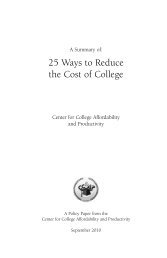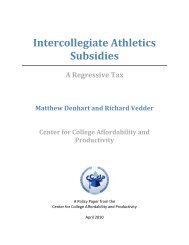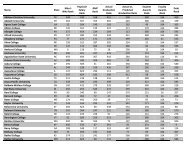Twelve Inconvenient Truths About Higher Education - The Center for ...
Twelve Inconvenient Truths About Higher Education - The Center for ...
Twelve Inconvenient Truths About Higher Education - The Center for ...
Create successful ePaper yourself
Turn your PDF publications into a flip-book with our unique Google optimized e-Paper software.
TWELVE INCONVENIENT TRUTHS ABOUT HIGHER EDUCATION<br />
<strong>Inconvenient</strong> Truth #9:<br />
Colleges Are Not a Force <strong>for</strong> Income Equality<br />
One of the major justifications of governmental support of higher education is that government<br />
subsidies are needed to increase participation by lower income Americans in college, in order to<br />
increase income equality and promote the American Dream. It is an article of faith that state universities<br />
do this. <strong>The</strong> evidence, however, tells us something different.<br />
In 1970, be<strong>for</strong>e we had much of a federal student loan program and be<strong>for</strong>e Pell Grants even existed, a<br />
larger proportion of college students were from lower income backgrounds than is true today. In 1970,<br />
when we spent less than half the proportion of our income on higher education than we do now, measured<br />
income equality in the U.S. was far higher. More higher education has been associated with less, not<br />
more income equality.<br />
Moreover, within higher education, the gap between the haves and have-nots among schools has<br />
grown. <strong>The</strong> elite private schools that draw lots of affluent students have had far greater increases in<br />
spending than the public schools, and not a single public school is in the top 20 on either the U.S. News<br />
or Forbes list of top American colleges today. Moreover, even some state universities are becoming elitist<br />
havens <strong>for</strong> the rich—the proportion of students receiving Pell Grants at the University of Virginia is lower<br />
in some years than it is at Harvard, <strong>for</strong> example. 10<br />
Daniel Bennett and I have been exploring the college attainment and income equality issue empirically<br />
with a massive set of panel data with 1,750 observations, looking at every state <strong>for</strong> every year from<br />
1970 through 2004. While our research is still ongoing, even after introducing other control variables that<br />
might explain variations in inequality over time and space, we generally find that income inequality is<br />
increased with the proportion of the adult population that has at least a bachelor’s degree.<br />
<strong>Inconvenient</strong> Truth #10:<br />
Colleges Are Run to Benefit Staff, Not Students<br />
While the title to this “inconvenient truth” may be a bit of an exaggeration (most college personnel<br />
genuinely also want to improve the lot of students, I suspect), a good case can nevertheless be<br />
made that a lot of what goes on at colleges these days is designed more to make life easier and more prosperous<br />
<strong>for</strong> the employees and occasionally the alumni than <strong>for</strong> the students or even funders of research<br />
grants. Not only are we in the era of multi-million dollar football coaches, but also the age of the million<br />
dollar college president (see Figure 4 <strong>for</strong> the rising in college president salaries over time) and one-third<br />
of a million dollar college professor. Teaching loads have fallen significantly over time, supposedly to support<br />
research, but much of that research is trivial extensions of minor esoteric explorations of issues of<br />
little interest to anyone, even to fellow academics.<br />
10







